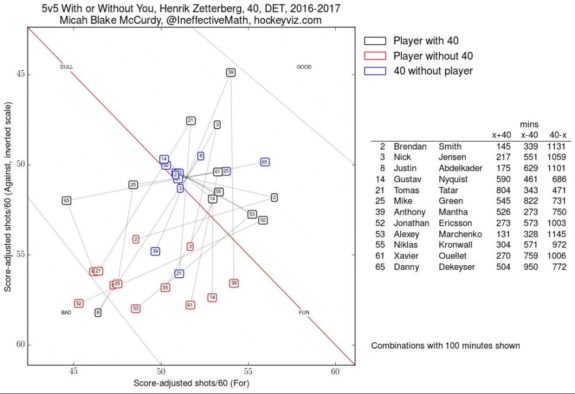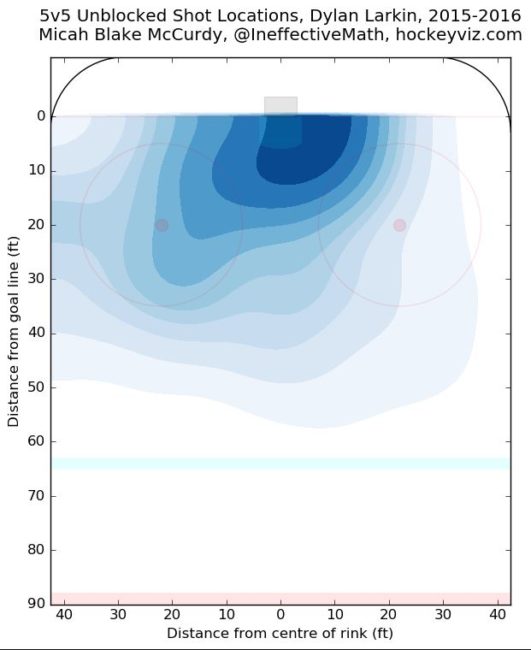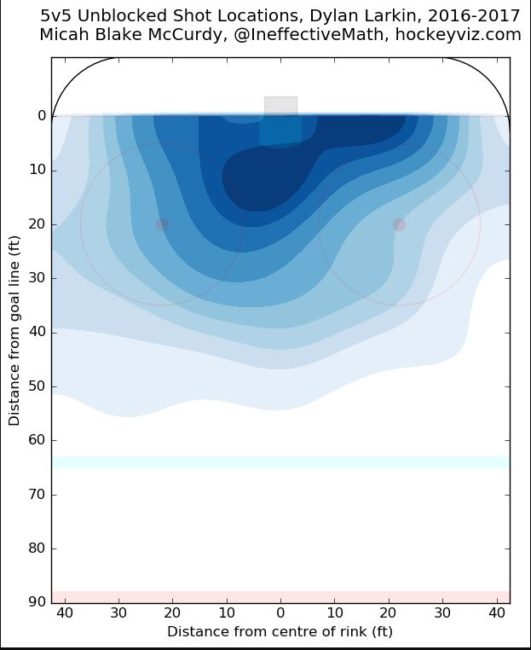Detroit Red Wings 2014 first-round pick Dylan Larkin was primed for a breakout season after scoring 45 points (23 goals, 22 assists) in 80 games during his rookie season last year.
However, Larkin suffered the sophomore slump, scoring just 32 points (17 goals, 15 assists) in 80 games this past season.
The Red Wings, as a whole, weren’t as good as last season, missing the playoffs for the first time in 26 seasons. However, not every player regressed, as captain Henrik Zetterberg improved on a 50-point season in 2015-16, scoring 68 points in 2016-17.
So, why did the 20-year-old Larkin regress this season? Let’s take a dive into his sophomore season.
Limited Playing Time with Zetterberg
One of the biggest reasons Larkin couldn’t surpass his point total from the 2015-16 season is because he didn’t play as many minutes with Zetterberg. Last season, Larkin played a total of 655 minutes at five on five with Zetterberg. This season, he played just 97 minutes, as Larkin spent most of his even strength time on a middle line with Tomas Tatar and Riley Sheahan.
We saw Tatar benefit from playing with Zetterberg. As evidenced by his WOWY chart from HockeyViz.com seen below, Tatar’s score-adjusted shots/60 against went down by about 10 shots/60 when he was with Zetterberg, and his shots for/60 went up by about five shots/60 when he played with Zetterberg.

In fact, almost every player Zetterberg played 100 minutes with benefitted from playing with him and nearly all of them faltered when they were on the ice without him.
Zetterberg, at 36 years old, still has the ability to create offense for himself and his teammates, and Larkin wasn’t able to get the same production from his linemates or create his own offense on a consistent basis.
Larkin Shot Less
Another reason Larkin struggled this season is he didn’t shoot the puck nearly as much as he did during his rookie season and playing without Zetterberg most of the season contributed to that. During his first season, Larkin had a five-on-five adjusted individual shot attempts for/60 of 17.30. This season, that dropped to 12.45. As a result, Larkin had 121 five-on-five shots on net compared to 171 shots in 2015-16. Larkin’s shot attempt for percentage also dropped, going from 51.13 in 2015-16 to 47.95.
Below is the 15-game rolling average of Larkin’s shot attempts for the past two seasons. As you can see, Larkin started to drop right around the All-Star break last season but finished strong toward the end of the season. This season, he kept his head above water until about December and was never able to get above the 50 percent mark for the remainder of the season.

Larkin’s concentration of shots in 2015-16 were more centered in front of the net below the hash marks, whereas this season, the concentration starts to creep above the hash marks as well as off to the right side of the net in a low-scoring area.


Larkin didn’t have the setup man in Zetterberg that he had in 2015-16, and it affected his shot production and location. Since Larkin didn’t shoot as much and lost Zetterberg, his expected goals dropped considerably. In 2015-16, he had a five-on-five individual expected goals mark of 14.59, and this season, it was 9.11.
What to Expect From Larkin in 2017-18
The big thing to remember is Larkin was only 20 years old this season; he’ll be 21 at the start of the 2017-18 season. Very few players are able to have consistent success at that age. Generational players, like Connor McDavid, are the exception, and while I think Larkin is a good player, he’s not a franchise-changing player like McDavid.

For the last month, Red Wings coach Jeff Blashill played Larkin at center after playing him on the wing most of the 2016-17 season and 2015-16 season. So, in addition to new linemates, Larkin had to attempt to play center in a league he hasn’t played the position often. Center is astronomically harder to play than the wing, and it’s even harder for a player who has less than 200 games under his belt.
Part of Larkin’s success during his rookie season was being an unknown player. However, once he started to produce and broke the fastest skater record at the All-Star Game, players started to take notice and defend him accordingly.
Now, it’s Larkin’s turn to adjust to the adjustments made to him, and he knows he needs to fix his game. While the Red Wings won’t be contending for a Stanley Cup next season, I expect Larkin to improve on his 32-point sophomore season and be more responsible defensively, as well.
All stats from Corsica.hockey unless otherwise noted.